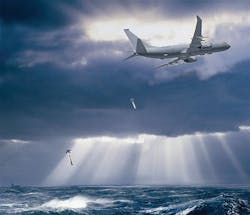Navy needs enabling technologies for new sonobuoy to detect quiet enemy submarines
ARLINGTON, Va. —U.S. Navy researchers are asking industry for enabling technologies for a new advanced air-deployed passive sonobuoy that can detect, identify, and track new generations of extremely quiet enemy submarines.
Officials of the Office of Naval Research in Arlington, Va., issued a solicitation (N00014-18-R-S008) for additional sonobuoy research as part of the organization’s Long Range Broad Agency Announcement (BAA) for Navy and Marine Corps Science and Technology.
The Navy is surveying industry for enabling technologies for next-generation sonobuoys able to detect and track quiet enemy submarines
Officials of the ONR Naval Research Ocean Battlespace Sensing Department are seeking new technologies to develop an advanced passive sonobuoy called the Extended Range Directional Frequency Analysis and Recording (ER-DIFAR) to address new quiet threat submarine targets.
They are looking for a new A-size sonobuoy that measures 36 inches long, 5.25 inches in diameter, and weighs 39 pounds. This new sonobuoy should offer passive detection at tactically significant ranges against extremely quiet targets.
A government conceptual hydrophone array design will serve as the basis for maturing the sonobuoy design, as well as for developing and demonstrating a prototype.
Goals are to deploy the prototype from an A-size package; automatic precise localization of hydrophone elements on the hydrophone array; and in-buoy signal processing for beam-forming and communicating data to a receiving system.
Included will be upper float, communications and GPS receiver, and surface suspension for motion isolation of the upper assembly from the array. A lower electronics section will have power for the sonar hydrophone array, telemetry, beamforming, and signal processing hardware with sufficient processing power to run software developed and provided by the Navy.
The winning contractor will integrate components into an A-size sonobuoy and demonstrate the ability to achieve air launch certification, water entry, and array deployment in an at-sea demonstration.
The cost of manufacturing the sonobuoy in small numbers is a key objective. A-size sonobuoy packaging imposes severe restrictions on the size of hydrophone, which must be non-developmental.
Companies interested should email four-page white papers to the Office of Naval Research’s David Johnson at [email protected]. Full proposals will be due no later than 1 Feb. 2019.
More information is online at https://www.fbo.gov/spg/DON/ONR/ONR/N00014-18-R-S008/listing.html.

John Keller | Editor
John Keller is editor-in-chief of Military & Aerospace Electronics magazine, which provides extensive coverage and analysis of enabling electronic and optoelectronic technologies in military, space, and commercial aviation applications. A member of the Military & Aerospace Electronics staff since the magazine's founding in 1989, Mr. Keller took over as chief editor in 1995.

